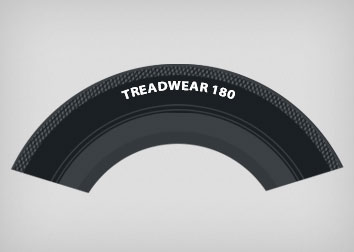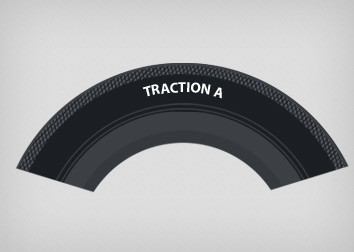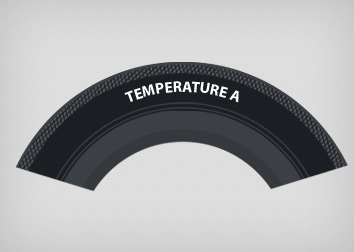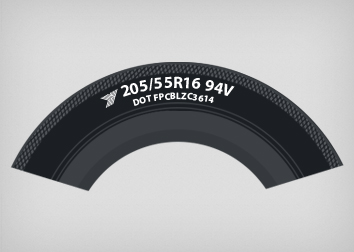UTQG
UNIFORM TIRE QUALITY GRADE (UTQG) LABELING
Required by the government, the UTQG provides comparative manufacturer information. Tires are subjected to a series of government-mandated tests that measure performance in treadwear, traction, and temperature resistance. All testing is done by the tire manufacturer.
TREADWEAR
Treadwear is a measurement of tread durability. Tested against an industry standard, the assigned numerical grade indicates how well the tread lasts compared to an index standard of 100. A treadwear rating of 200 means the tread wears twice as well as the standard. Actual wear depends on the conditions under which the tire is used. Driving habits, service practices, differences in road surface, and varying climates all affect treadwear.

TRACTION
Traction is a measurement of a tire's ability to stop on wet test surfaces of asphalt and concrete under controlled conditions. Traction grades are assigned by the UTQG system and branded on the sidewall. Traction grade is determined only for straight-ahead, wet braking on concrete and asphalt. It doesn't include cornering, which may also be an important customer performance need.
-
Traction Grade A: The tire performed well on both surfaces.
-
Traction Grade B: The tire performed well on at least one of the surfaces.
-
Traction Grade C: The tire performed poorly on one or both of the surfaces.

TEMPERATURE RESISTANCE
The UTQG also provides a measure of resistance to heat generation under normal operating conditions. The test is conducted under predetermined standards for inflation and loading. Excessive speed, underinflation and overloading can all cause adverse heat buildup. Sustained high temperatures can reduce tire durability. Resistance grades are branded on the sidewall.
-
Resistance Grade A: The maximum performance level indicating the tire withstood a half-hour run at 185 kmh without failing.
-
Resistance Grade B: The tire passed 160 kmh but not 185 kmh.
-
Resistance Grade C: The minimum performance level indicating that the tire failed to complete a half-hour at 160 kmh.

DEPARTMENT OF TRANSPORTATION (DOT) CERTIFICATION
DOT is branded on the tire's sidewall indicating the tire is certified by the Department of Transportation. Following the DOT branding is a serial number designating the tire manufacturer, manufacturing plant, tire size and date of manufacture. Federal law requires that tire dealers record the DOT identification numbers, along with the tire buyer's name and address.

MUD AND SNOW LABELING
If a tire is rated for safe performance in mud and snow, it will be noted on the sidewall of the tire with either M/S, M+S, or M&S. A tire is certified under the definitions set forth by the Rubber Manufacturers Association (RMA).
TIRE CONSTRUCTION LABELING
Tread ply and sidewall ply information, including tire ply composition and materials used, must also be identified. An example would be: Tread: 2 Plies Rayon + 4 Plies Fiberglass Sidewall: 2 Plies Rayon.

 Automotive
Automotive  Commercial
Commercial  OTR
OTR